Drug Addiction, Behavior Change Theories, and Public Health Essay
VerifiedAdded on 2023/01/13
|6
|1542
|36
Essay
AI Summary
This essay delves into the multifaceted issue of drug addiction as a critical public health concern. It begins by highlighting the increasing significance of health-related behavior change in addressing the growing incidence of drug abuse and its associated consequences. The essay then provides an overview of prominent health-related behavior change theories, including the social cognitive theory, the theory of planned behavior, and the self-determination theory, outlining their core principles and applications. Furthermore, the essay critically examines the use of these behavior change theories in public health policy, assessing their effectiveness in addressing behaviors shaped by primary and secondary socialization. It discusses the limitations of these theories, particularly in addressing complex social and environmental influences on behavior. The essay concludes by emphasizing the need for a comprehensive approach to address drug addiction, considering the diverse factors that influence behavior change and the limitations of any single theory. The student ID, references, and assignment brief are also included.
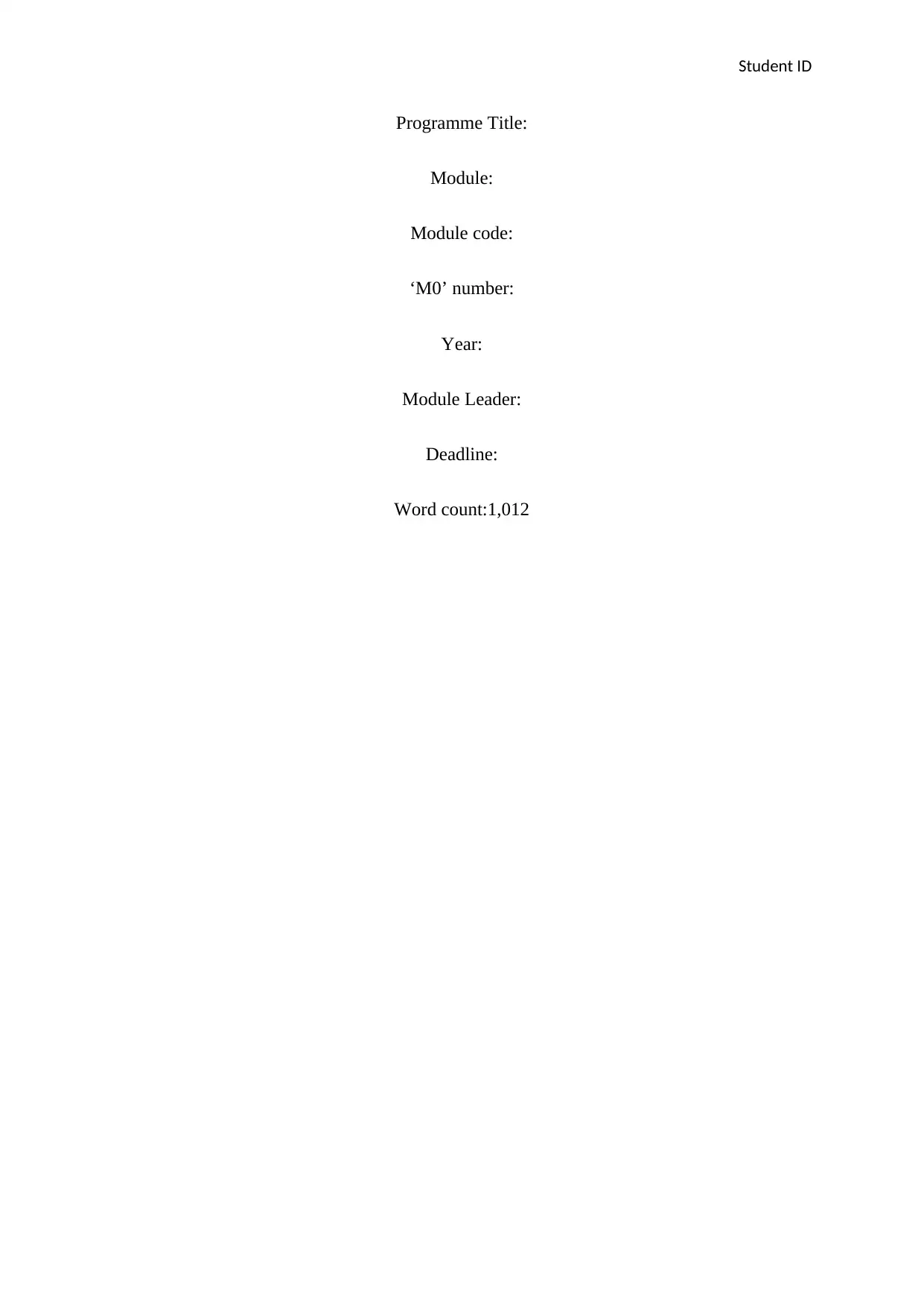
Student ID
Programme Title:
Module:
Module code:
‘M0’ number:
Year:
Module Leader:
Deadline:
Word count:1,012
Programme Title:
Module:
Module code:
‘M0’ number:
Year:
Module Leader:
Deadline:
Word count:1,012
Paraphrase This Document
Need a fresh take? Get an instant paraphrase of this document with our AI Paraphraser
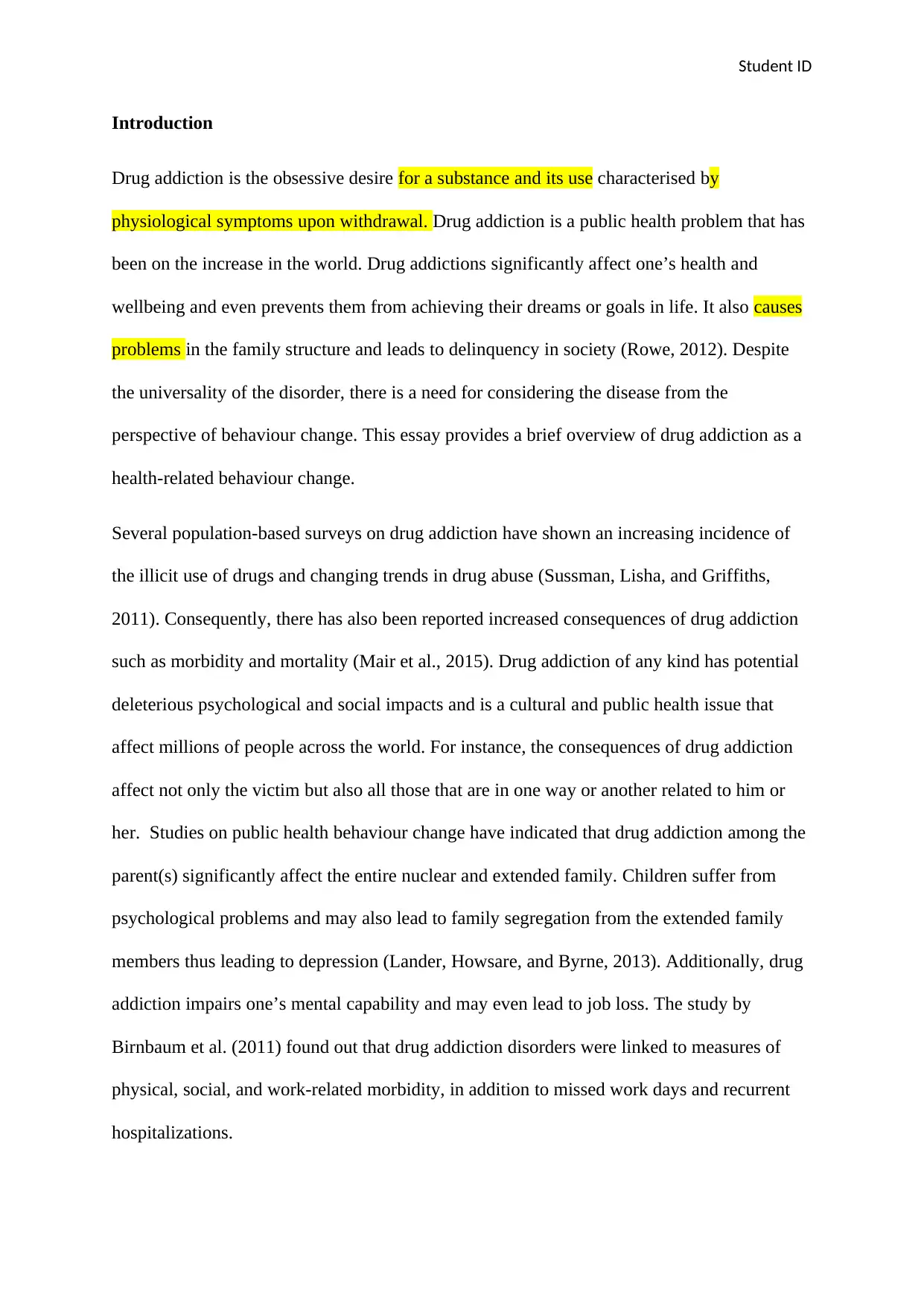
Student ID
Introduction
Drug addiction is the obsessive desire for a substance and its use characterised by
physiological symptoms upon withdrawal. Drug addiction is a public health problem that has
been on the increase in the world. Drug addictions significantly affect one’s health and
wellbeing and even prevents them from achieving their dreams or goals in life. It also causes
problems in the family structure and leads to delinquency in society (Rowe, 2012). Despite
the universality of the disorder, there is a need for considering the disease from the
perspective of behaviour change. This essay provides a brief overview of drug addiction as a
health-related behaviour change.
Several population-based surveys on drug addiction have shown an increasing incidence of
the illicit use of drugs and changing trends in drug abuse (Sussman, Lisha, and Griffiths,
2011). Consequently, there has also been reported increased consequences of drug addiction
such as morbidity and mortality (Mair et al., 2015). Drug addiction of any kind has potential
deleterious psychological and social impacts and is a cultural and public health issue that
affect millions of people across the world. For instance, the consequences of drug addiction
affect not only the victim but also all those that are in one way or another related to him or
her. Studies on public health behaviour change have indicated that drug addiction among the
parent(s) significantly affect the entire nuclear and extended family. Children suffer from
psychological problems and may also lead to family segregation from the extended family
members thus leading to depression (Lander, Howsare, and Byrne, 2013). Additionally, drug
addiction impairs one’s mental capability and may even lead to job loss. The study by
Birnbaum et al. (2011) found out that drug addiction disorders were linked to measures of
physical, social, and work-related morbidity, in addition to missed work days and recurrent
hospitalizations.
Introduction
Drug addiction is the obsessive desire for a substance and its use characterised by
physiological symptoms upon withdrawal. Drug addiction is a public health problem that has
been on the increase in the world. Drug addictions significantly affect one’s health and
wellbeing and even prevents them from achieving their dreams or goals in life. It also causes
problems in the family structure and leads to delinquency in society (Rowe, 2012). Despite
the universality of the disorder, there is a need for considering the disease from the
perspective of behaviour change. This essay provides a brief overview of drug addiction as a
health-related behaviour change.
Several population-based surveys on drug addiction have shown an increasing incidence of
the illicit use of drugs and changing trends in drug abuse (Sussman, Lisha, and Griffiths,
2011). Consequently, there has also been reported increased consequences of drug addiction
such as morbidity and mortality (Mair et al., 2015). Drug addiction of any kind has potential
deleterious psychological and social impacts and is a cultural and public health issue that
affect millions of people across the world. For instance, the consequences of drug addiction
affect not only the victim but also all those that are in one way or another related to him or
her. Studies on public health behaviour change have indicated that drug addiction among the
parent(s) significantly affect the entire nuclear and extended family. Children suffer from
psychological problems and may also lead to family segregation from the extended family
members thus leading to depression (Lander, Howsare, and Byrne, 2013). Additionally, drug
addiction impairs one’s mental capability and may even lead to job loss. The study by
Birnbaum et al. (2011) found out that drug addiction disorders were linked to measures of
physical, social, and work-related morbidity, in addition to missed work days and recurrent
hospitalizations.
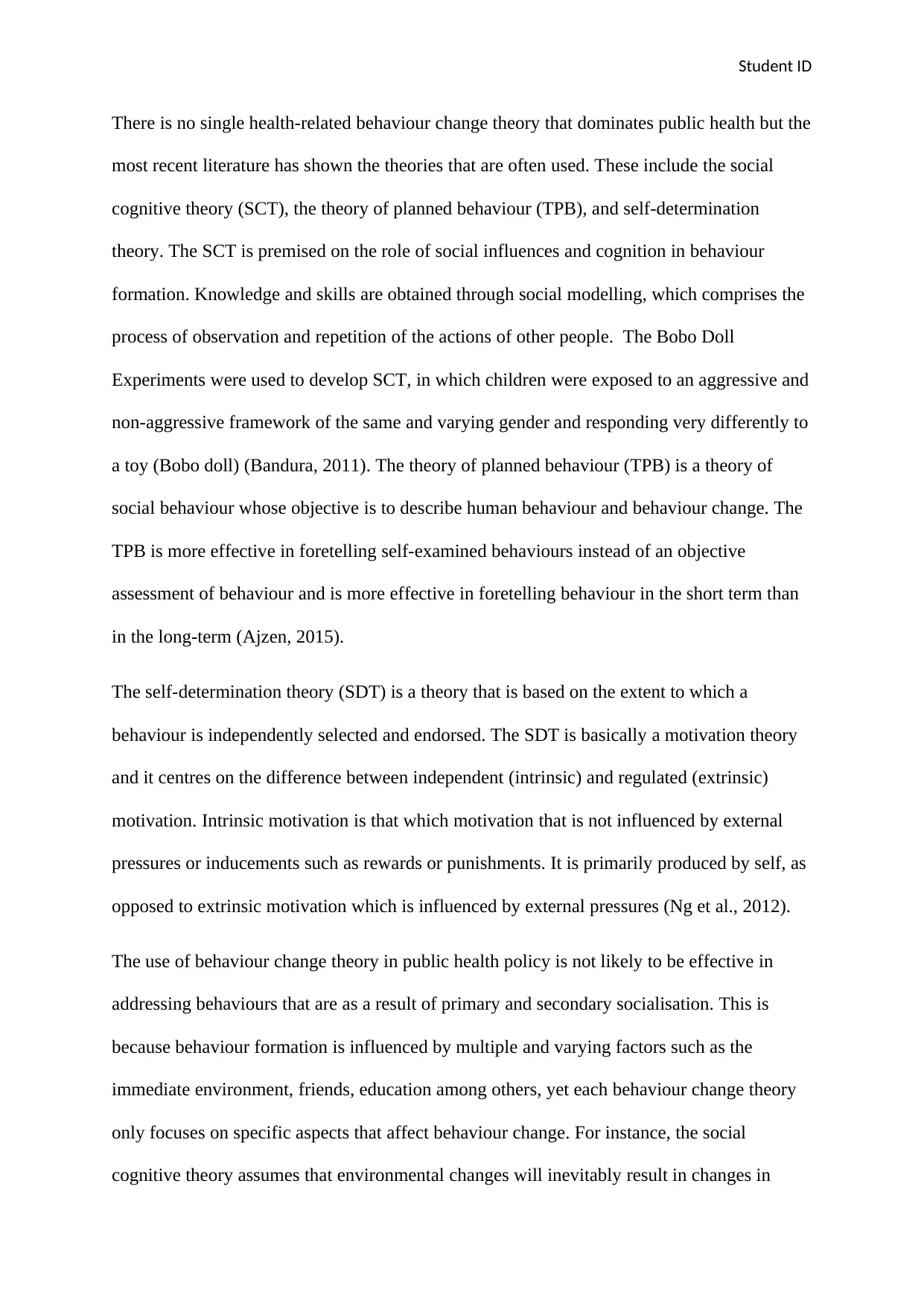
Student ID
There is no single health-related behaviour change theory that dominates public health but the
most recent literature has shown the theories that are often used. These include the social
cognitive theory (SCT), the theory of planned behaviour (TPB), and self-determination
theory. The SCT is premised on the role of social influences and cognition in behaviour
formation. Knowledge and skills are obtained through social modelling, which comprises the
process of observation and repetition of the actions of other people. The Bobo Doll
Experiments were used to develop SCT, in which children were exposed to an aggressive and
non-aggressive framework of the same and varying gender and responding very differently to
a toy (Bobo doll) (Bandura, 2011). The theory of planned behaviour (TPB) is a theory of
social behaviour whose objective is to describe human behaviour and behaviour change. The
TPB is more effective in foretelling self-examined behaviours instead of an objective
assessment of behaviour and is more effective in foretelling behaviour in the short term than
in the long-term (Ajzen, 2015).
The self-determination theory (SDT) is a theory that is based on the extent to which a
behaviour is independently selected and endorsed. The SDT is basically a motivation theory
and it centres on the difference between independent (intrinsic) and regulated (extrinsic)
motivation. Intrinsic motivation is that which motivation that is not influenced by external
pressures or inducements such as rewards or punishments. It is primarily produced by self, as
opposed to extrinsic motivation which is influenced by external pressures (Ng et al., 2012).
The use of behaviour change theory in public health policy is not likely to be effective in
addressing behaviours that are as a result of primary and secondary socialisation. This is
because behaviour formation is influenced by multiple and varying factors such as the
immediate environment, friends, education among others, yet each behaviour change theory
only focuses on specific aspects that affect behaviour change. For instance, the social
cognitive theory assumes that environmental changes will inevitably result in changes in
There is no single health-related behaviour change theory that dominates public health but the
most recent literature has shown the theories that are often used. These include the social
cognitive theory (SCT), the theory of planned behaviour (TPB), and self-determination
theory. The SCT is premised on the role of social influences and cognition in behaviour
formation. Knowledge and skills are obtained through social modelling, which comprises the
process of observation and repetition of the actions of other people. The Bobo Doll
Experiments were used to develop SCT, in which children were exposed to an aggressive and
non-aggressive framework of the same and varying gender and responding very differently to
a toy (Bobo doll) (Bandura, 2011). The theory of planned behaviour (TPB) is a theory of
social behaviour whose objective is to describe human behaviour and behaviour change. The
TPB is more effective in foretelling self-examined behaviours instead of an objective
assessment of behaviour and is more effective in foretelling behaviour in the short term than
in the long-term (Ajzen, 2015).
The self-determination theory (SDT) is a theory that is based on the extent to which a
behaviour is independently selected and endorsed. The SDT is basically a motivation theory
and it centres on the difference between independent (intrinsic) and regulated (extrinsic)
motivation. Intrinsic motivation is that which motivation that is not influenced by external
pressures or inducements such as rewards or punishments. It is primarily produced by self, as
opposed to extrinsic motivation which is influenced by external pressures (Ng et al., 2012).
The use of behaviour change theory in public health policy is not likely to be effective in
addressing behaviours that are as a result of primary and secondary socialisation. This is
because behaviour formation is influenced by multiple and varying factors such as the
immediate environment, friends, education among others, yet each behaviour change theory
only focuses on specific aspects that affect behaviour change. For instance, the social
cognitive theory assumes that environmental changes will inevitably result in changes in
⊘ This is a preview!⊘
Do you want full access?
Subscribe today to unlock all pages.

Trusted by 1+ million students worldwide
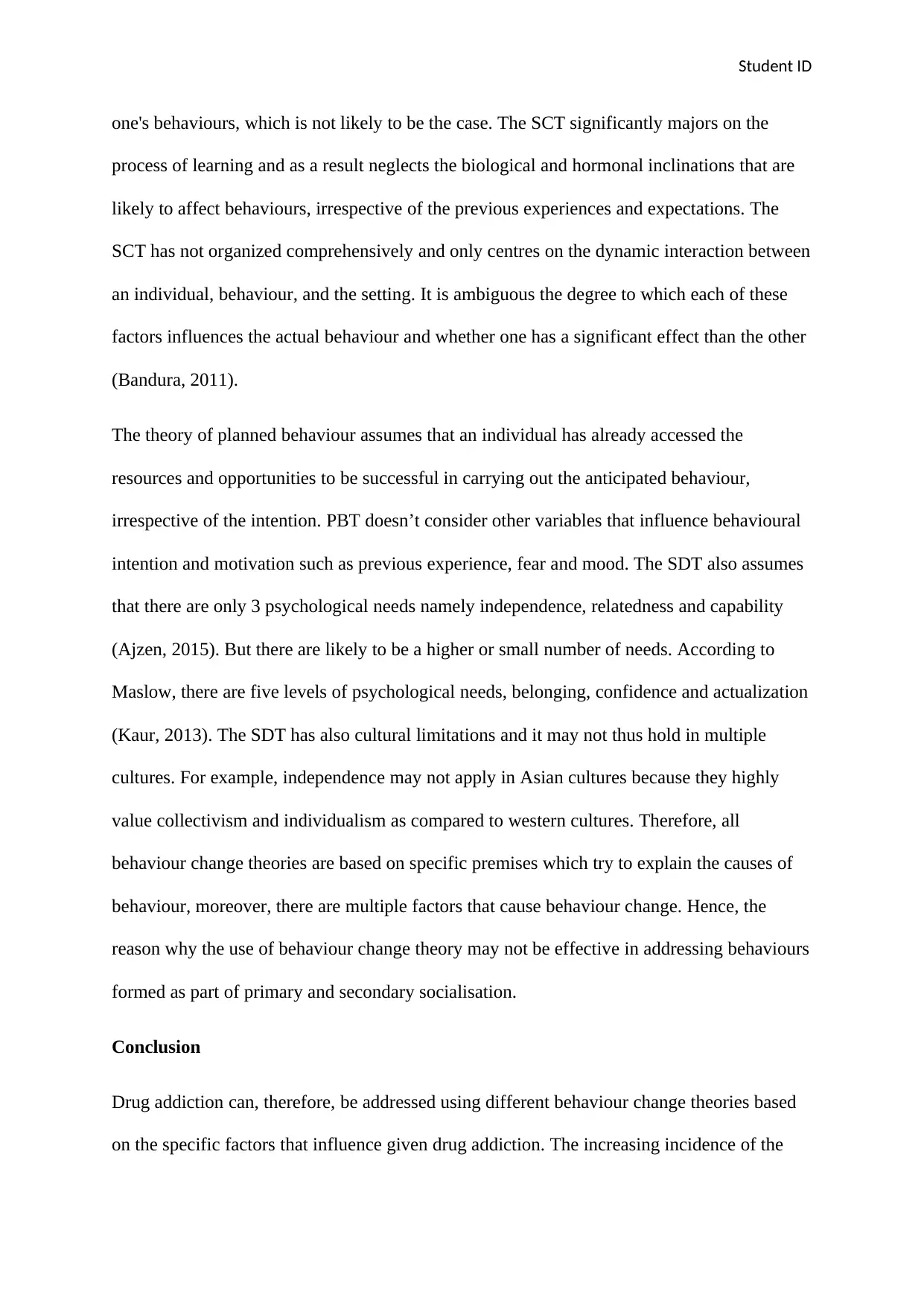
Student ID
one's behaviours, which is not likely to be the case. The SCT significantly majors on the
process of learning and as a result neglects the biological and hormonal inclinations that are
likely to affect behaviours, irrespective of the previous experiences and expectations. The
SCT has not organized comprehensively and only centres on the dynamic interaction between
an individual, behaviour, and the setting. It is ambiguous the degree to which each of these
factors influences the actual behaviour and whether one has a significant effect than the other
(Bandura, 2011).
The theory of planned behaviour assumes that an individual has already accessed the
resources and opportunities to be successful in carrying out the anticipated behaviour,
irrespective of the intention. PBT doesn’t consider other variables that influence behavioural
intention and motivation such as previous experience, fear and mood. The SDT also assumes
that there are only 3 psychological needs namely independence, relatedness and capability
(Ajzen, 2015). But there are likely to be a higher or small number of needs. According to
Maslow, there are five levels of psychological needs, belonging, confidence and actualization
(Kaur, 2013). The SDT has also cultural limitations and it may not thus hold in multiple
cultures. For example, independence may not apply in Asian cultures because they highly
value collectivism and individualism as compared to western cultures. Therefore, all
behaviour change theories are based on specific premises which try to explain the causes of
behaviour, moreover, there are multiple factors that cause behaviour change. Hence, the
reason why the use of behaviour change theory may not be effective in addressing behaviours
formed as part of primary and secondary socialisation.
Conclusion
Drug addiction can, therefore, be addressed using different behaviour change theories based
on the specific factors that influence given drug addiction. The increasing incidence of the
one's behaviours, which is not likely to be the case. The SCT significantly majors on the
process of learning and as a result neglects the biological and hormonal inclinations that are
likely to affect behaviours, irrespective of the previous experiences and expectations. The
SCT has not organized comprehensively and only centres on the dynamic interaction between
an individual, behaviour, and the setting. It is ambiguous the degree to which each of these
factors influences the actual behaviour and whether one has a significant effect than the other
(Bandura, 2011).
The theory of planned behaviour assumes that an individual has already accessed the
resources and opportunities to be successful in carrying out the anticipated behaviour,
irrespective of the intention. PBT doesn’t consider other variables that influence behavioural
intention and motivation such as previous experience, fear and mood. The SDT also assumes
that there are only 3 psychological needs namely independence, relatedness and capability
(Ajzen, 2015). But there are likely to be a higher or small number of needs. According to
Maslow, there are five levels of psychological needs, belonging, confidence and actualization
(Kaur, 2013). The SDT has also cultural limitations and it may not thus hold in multiple
cultures. For example, independence may not apply in Asian cultures because they highly
value collectivism and individualism as compared to western cultures. Therefore, all
behaviour change theories are based on specific premises which try to explain the causes of
behaviour, moreover, there are multiple factors that cause behaviour change. Hence, the
reason why the use of behaviour change theory may not be effective in addressing behaviours
formed as part of primary and secondary socialisation.
Conclusion
Drug addiction can, therefore, be addressed using different behaviour change theories based
on the specific factors that influence given drug addiction. The increasing incidence of the
Paraphrase This Document
Need a fresh take? Get an instant paraphrase of this document with our AI Paraphraser
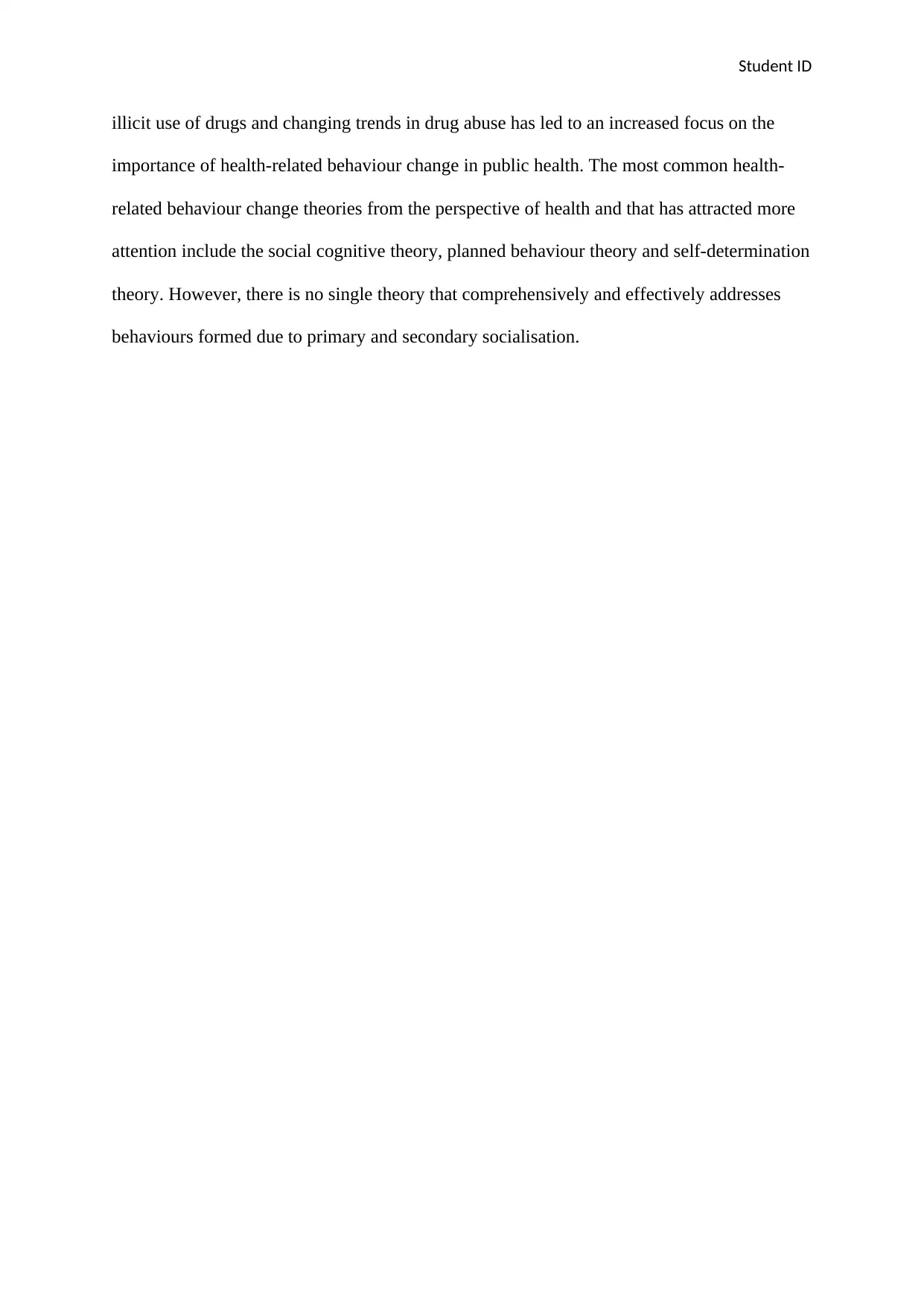
Student ID
illicit use of drugs and changing trends in drug abuse has led to an increased focus on the
importance of health-related behaviour change in public health. The most common health-
related behaviour change theories from the perspective of health and that has attracted more
attention include the social cognitive theory, planned behaviour theory and self-determination
theory. However, there is no single theory that comprehensively and effectively addresses
behaviours formed due to primary and secondary socialisation.
illicit use of drugs and changing trends in drug abuse has led to an increased focus on the
importance of health-related behaviour change in public health. The most common health-
related behaviour change theories from the perspective of health and that has attracted more
attention include the social cognitive theory, planned behaviour theory and self-determination
theory. However, there is no single theory that comprehensively and effectively addresses
behaviours formed due to primary and secondary socialisation.
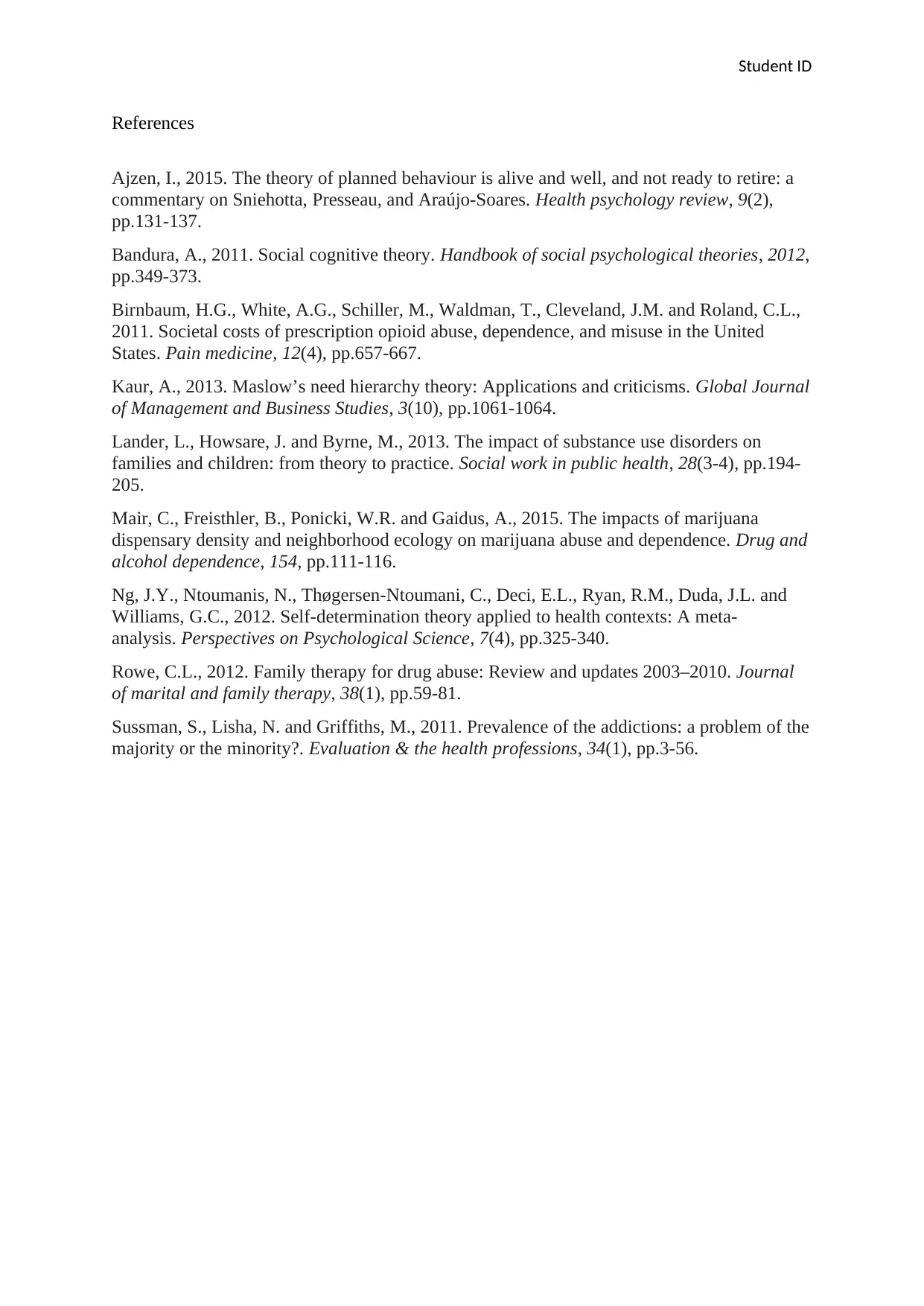
Student ID
References
Ajzen, I., 2015. The theory of planned behaviour is alive and well, and not ready to retire: a
commentary on Sniehotta, Presseau, and Araújo-Soares. Health psychology review, 9(2),
pp.131-137.
Bandura, A., 2011. Social cognitive theory. Handbook of social psychological theories, 2012,
pp.349-373.
Birnbaum, H.G., White, A.G., Schiller, M., Waldman, T., Cleveland, J.M. and Roland, C.L.,
2011. Societal costs of prescription opioid abuse, dependence, and misuse in the United
States. Pain medicine, 12(4), pp.657-667.
Kaur, A., 2013. Maslow’s need hierarchy theory: Applications and criticisms. Global Journal
of Management and Business Studies, 3(10), pp.1061-1064.
Lander, L., Howsare, J. and Byrne, M., 2013. The impact of substance use disorders on
families and children: from theory to practice. Social work in public health, 28(3-4), pp.194-
205.
Mair, C., Freisthler, B., Ponicki, W.R. and Gaidus, A., 2015. The impacts of marijuana
dispensary density and neighborhood ecology on marijuana abuse and dependence. Drug and
alcohol dependence, 154, pp.111-116.
Ng, J.Y., Ntoumanis, N., Thøgersen-Ntoumani, C., Deci, E.L., Ryan, R.M., Duda, J.L. and
Williams, G.C., 2012. Self-determination theory applied to health contexts: A meta-
analysis. Perspectives on Psychological Science, 7(4), pp.325-340.
Rowe, C.L., 2012. Family therapy for drug abuse: Review and updates 2003–2010. Journal
of marital and family therapy, 38(1), pp.59-81.
Sussman, S., Lisha, N. and Griffiths, M., 2011. Prevalence of the addictions: a problem of the
majority or the minority?. Evaluation & the health professions, 34(1), pp.3-56.
References
Ajzen, I., 2015. The theory of planned behaviour is alive and well, and not ready to retire: a
commentary on Sniehotta, Presseau, and Araújo-Soares. Health psychology review, 9(2),
pp.131-137.
Bandura, A., 2011. Social cognitive theory. Handbook of social psychological theories, 2012,
pp.349-373.
Birnbaum, H.G., White, A.G., Schiller, M., Waldman, T., Cleveland, J.M. and Roland, C.L.,
2011. Societal costs of prescription opioid abuse, dependence, and misuse in the United
States. Pain medicine, 12(4), pp.657-667.
Kaur, A., 2013. Maslow’s need hierarchy theory: Applications and criticisms. Global Journal
of Management and Business Studies, 3(10), pp.1061-1064.
Lander, L., Howsare, J. and Byrne, M., 2013. The impact of substance use disorders on
families and children: from theory to practice. Social work in public health, 28(3-4), pp.194-
205.
Mair, C., Freisthler, B., Ponicki, W.R. and Gaidus, A., 2015. The impacts of marijuana
dispensary density and neighborhood ecology on marijuana abuse and dependence. Drug and
alcohol dependence, 154, pp.111-116.
Ng, J.Y., Ntoumanis, N., Thøgersen-Ntoumani, C., Deci, E.L., Ryan, R.M., Duda, J.L. and
Williams, G.C., 2012. Self-determination theory applied to health contexts: A meta-
analysis. Perspectives on Psychological Science, 7(4), pp.325-340.
Rowe, C.L., 2012. Family therapy for drug abuse: Review and updates 2003–2010. Journal
of marital and family therapy, 38(1), pp.59-81.
Sussman, S., Lisha, N. and Griffiths, M., 2011. Prevalence of the addictions: a problem of the
majority or the minority?. Evaluation & the health professions, 34(1), pp.3-56.
⊘ This is a preview!⊘
Do you want full access?
Subscribe today to unlock all pages.

Trusted by 1+ million students worldwide
1 out of 6
Related Documents
Your All-in-One AI-Powered Toolkit for Academic Success.
+13062052269
info@desklib.com
Available 24*7 on WhatsApp / Email
![[object Object]](/_next/static/media/star-bottom.7253800d.svg)
Unlock your academic potential
Copyright © 2020–2025 A2Z Services. All Rights Reserved. Developed and managed by ZUCOL.




